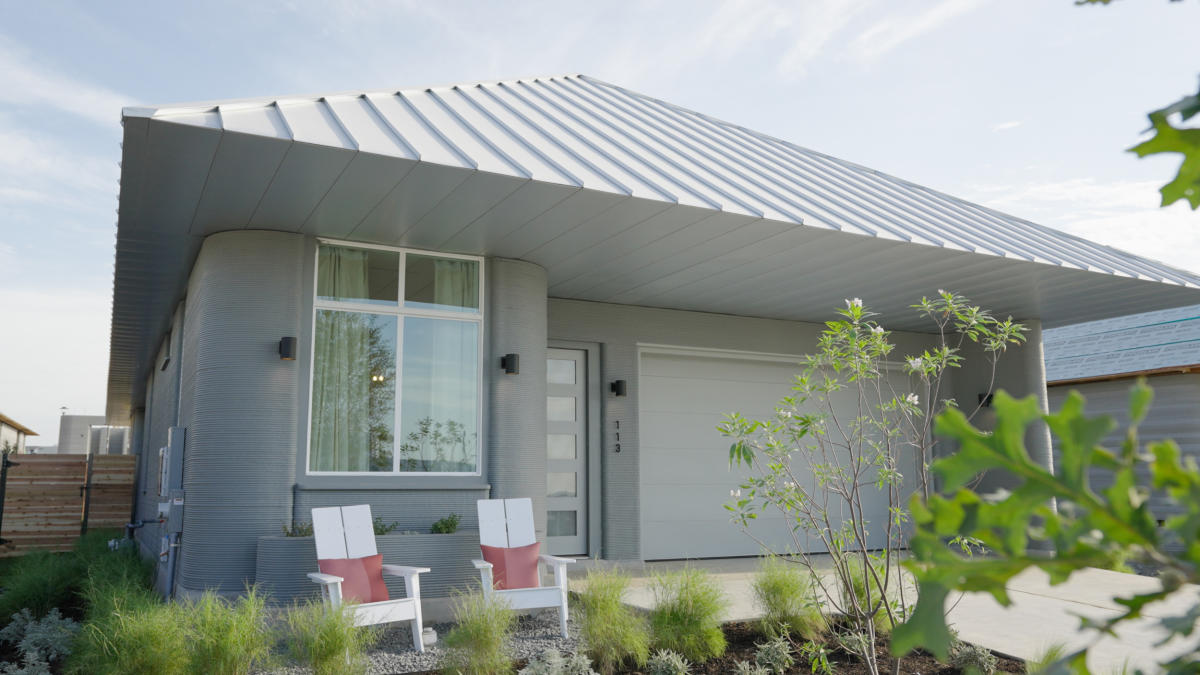Introduction to 3D Printed Homes
The concept of 3D printed homes has been gaining traction in recent years, with various companies and developers exploring its potential to revolutionize the construction industry. One notable example is the collaboration between ICON, a 3D printing construction developer, and Lennar, a home construction company, to build a community of homes in Georgetown, Texas.
The Wolf Ranch community, as it’s called, features 100 homes made possible by ICON’s large-scale 3D printer, the Vulcan. This massive machine is 45 feet wide and weighs over 4.75 tons, capable of laying down stacks of tube-shaped concrete to construct walls and eventually an entire house. The printer uses a mixture of concrete powder, water, sand, and other materials to create the structures, which are then strengthened by a specialized process.
The homes being built in Wolf Ranch are single-story dwellings with three to four bedrooms, each taking around three weeks to print. While the foundation and metal roofs are constructed using traditional methods, the walls are created entirely by the 3D printer. The designs for the homes were provided by the architectural firm BIG-Bjarke Ingels Group, which aimed to create a contemporary ranch-style aesthetic.
The benefits of 3D printed homes are numerous, including increased speed, reduced labor costs, and improved sustainability. The structures are designed to be resilient and water-resistant, making them ideal for extreme weather conditions. Moreover, the use of local materials and minimized waste reduces the environmental impact of construction.
The success of the Wolf Ranch project has sparked interest in the potential applications of 3D printing technology. NASA, for instance, is reportedly exploring the use of ICON’s 3D printing capabilities to build structures on the moon as part of its Artemis program. As the technology continues to evolve, it’s likely that we’ll see more innovative applications of 3D printing in various industries, including construction.
The Vulcan 3D Printer and Its Capabilities
The Vulcan 3D printer is a game-changer in the construction industry, capable of building homes at an unprecedented scale and speed. This massive machine is 45 feet wide and weighs over 4.75 tons, making it one of the largest 3D printers in the world. Its size and weight allow it to handle large-scale construction projects, making it an ideal tool for building entire communities.
Print Process

The Vulcan 3D printer uses a unique print process to create the structures. It lays down stacks of tube-shaped concrete, which are then strengthened by a specialized process. The printer uses a mixture of concrete powder, water, sand, and other materials to create the walls, which are designed to be resilient and water-resistant.
Materials and Construction
The Vulcan 3D printer is capable of using a wide range of materials, including concrete, steel, and insulation. This allows for the creation of complex structures with varying levels of strength and durability. The printer can also be customized to use local materials, reducing the environmental impact of construction.
Advantages of the Vulcan 3D Printer

The Vulcan 3D printer offers several advantages over traditional construction methods. It can build homes at a much faster rate, with each home taking around three weeks to print. This reduces labor costs and increases efficiency. Additionally, the printer can produce structures with a high level of accuracy and precision, reducing the need for manual labor and minimizing errors.
The Vulcan 3D printer is a powerful tool in the construction industry, capable of building homes at an unprecedented scale and speed. Its unique print process and ability to use a wide range of materials make it an ideal tool for building entire communities.
The Wolf Ranch Community and Home Details
The Wolf Ranch community in Georgetown, Texas is a groundbreaking project that showcases the potential of 3D printed homes. This innovative community features 100 homes built using ICON’s Vulcan 3D printer. The homes are designed to be single-story dwellings with three to four bedrooms, each taking around three weeks to print.
Home Design and Architecture

The designs for the homes in Wolf Ranch were provided by the architectural firm BIG-Bjarke Ingels Group. The firm aimed to create a contemporary ranch-style aesthetic that would appeal to a wide range of buyers. The homes feature a mix of open-plan living areas, spacious bedrooms, and functional bathrooms.
Home Prices and Availability
The homes in Wolf Ranch are priced between $450,000 to $600,000, making them a competitive option in the Texas housing market. With over a quarter of the homes already sold, it’s clear that this innovative community is attracting attention from buyers looking for something new and exciting.
Home Features and Benefits

The homes in Wolf Ranch are designed to be resilient and water-resistant, making them ideal for extreme weather conditions. The structures are also energy-efficient, reducing the environmental impact of the community. Additionally, the use of local materials and minimized waste reduces the overall carbon footprint of the project.
Community Amenities
The Wolf Ranch community offers a range of amenities, including parks, trails, and community centers. The community is designed to be sustainable and eco-friendly, with a focus on reducing waste and minimizing environmental impact. As the community continues to grow, it’s clear that it will be a hub for innovation and sustainability in the Texas housing market.
Future Applications of 3D Printing Technology
The success of the Wolf Ranch project has sparked interest in the potential applications of 3D printing technology. ICON’s Vulcan 3D printer is being eyed by NASA for its potential to build structures on the moon as part of its Artemis program. This is just one example of the many potential uses of 3D printing technology in various industries.
Space Exploration and Construction

The use of 3D printing technology in space exploration and construction is a rapidly growing field. ICON’s Vulcan 3D printer is well-suited for building structures in space due to its ability to create complex shapes and structures using local materials. This technology could be used to build habitats, life support systems, and other critical infrastructure for future space missions.
Other Potential Applications
The potential applications of 3D printing technology extend far beyond space exploration and construction. It could be used in the following industries:
*
- Construction: 3D printing technology could be used to build entire cities, reducing labor costs and increasing efficiency.
- Manufacturing: 3D printing technology could be used to create complex parts and products, reducing production costs and increasing precision.
- Healthcare: 3D printing technology could be used to create custom prosthetics, implants, and other medical devices.
Advantages of 3D Printing Technology
The advantages of 3D printing technology are numerous. It offers:
*
- Increased speed and efficiency
- Reduced labor costs
- Improved precision and accuracy
- Ability to create complex shapes and structures
As the technology continues to evolve, we can expect to see even more innovative applications of 3D printing in various industries.
Benefits and Challenges of 3D Printed Housing
The use of 3D printed housing has several benefits, including increased speed, reduced labor costs, and improved sustainability. However, there are also challenges associated with this technology.
Benefits of 3D Printed Housing
The benefits of 3D printed housing include:
*
- Increased speed: 3D printed housing can be built much faster than traditional construction methods.
- Reduced labor costs: 3D printing technology can reduce labor costs by automating the construction process.
- Improved sustainability: 3D printed housing can be built using local and sustainable materials, reducing the environmental impact of construction.
- Increased precision: 3D printing technology can create complex shapes and structures with high precision and accuracy.
Challenges of 3D Printed Housing
Despite the benefits of 3D printed housing, there are also several challenges associated with this technology. These challenges include:
*
- High upfront costs: The cost of purchasing and maintaining 3D printing equipment can be high.
- Limited scalability: 3D printing technology may not be scalable for large-scale construction projects.
- Material limitations: The types of materials that can be used for 3D printing are limited, which can restrict design options.
- Code and regulation challenges: 3D printed housing may not meet local building codes and regulations, which can create challenges for builders and developers.
Overcoming the Challenges of 3D Printed Housing
While there are challenges associated with 3D printed housing, these challenges can be overcome with further research and development. By addressing these challenges, builders and developers can take advantage of the benefits of 3D printed housing and create sustainable, efficient, and affordable housing options.



Add Comment